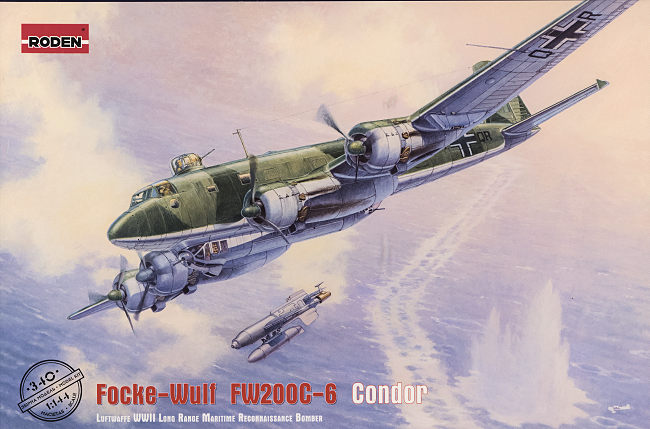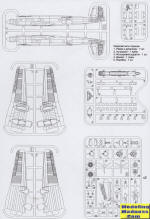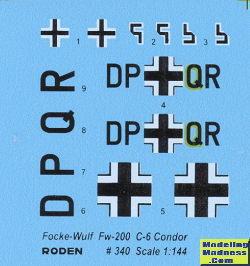
Roden 1/144 FW-200C-6 Condor
| KIT #: | 340 |
| PRICE: | $20.00 or so |
| DECALS: | one option |
| REVIEWER: | Scott Van Aken |
| NOTES: | 2020 tooling |

| HISTORY |
he Focke-Wulf Fw 200 Condor, also known as Kurier to the Allies (English: Courier), was a German all-metal four-engined monoplane originally developed by Focke-Wulf as a long-range airliner. A Japanese request for a long-range maritime patrol aircraft led to military versions that saw service with the Luftwaffe as long-range reconnaissance and anti-shipping/maritime patrol bomber aircraft. The Luftwaffe also made extensive use of the Fw 200 as a transport aircraft.
It achieved success as a commerce raider until mid-1941, during which it was known as the 'scourge of the Atlantic'. It resulted in development of CAM ships which used a catapulted Hurricane to deal with the Condor. After the introduction of these ships, long-range RAF Coastal Command aircraft and the escort carrier, the FW-200 became considerably less effective, though was still quite useful in the reconnaissance role.
The Luftwaffe initially used the aircraft to support the Kriegsmarine, making great loops out across the North Sea and, following the fall of France, the Atlantic Ocean. The aircraft was used for maritime patrols and reconnaissance, searching for Allied convoys and warships that could be reported for targeting by U-boats. The Fw 200 could also carry a 1,000-kilogram (2,200 lb) bomb load or naval mines to use against shipping, and it was claimed that from June 1940 to February 1941, they sank 331,122 tonnes (365,000 tons) of shipping despite a rather crude bombsight. The attacks were carried out at extremely low altitude in order to "bracket" the target ship with three bombs; this almost guaranteed a hit. Winston Churchill called the Fw 200 the "Scourge of the Atlantic" during the Battle of the Atlantic due to its contribution to the heavy Allied shipping losses.
Following the debut of what would become the Luftwaffe's primary seaborne maritime patrol aircraft, the rival trimotored BV 138C flying boat in March 1941; from mid-1941 Condor crews were instructed to stop attacking shipping and avoid all combat in order to preserve numbers. In August, the first Fw 200 was shot down by a CAM ship-launched Hawker Hurricane, and the arrival of the U.S.-built Grumman Martlet, operating from the Royal Navy's new escort carriers, posed a serious threat. On 14 August 1942, an Fw 200C-3 was the first German aircraft to be destroyed by USAAF pilots, after it was attacked by a P-40C and a P-38F over Iceland.
| THE KIT |
 Roden
has made quite a name for itself in terms of developing 1/144 scale kits and
this is the most recent release in this scale. If you have seen a modern Roden
kit, you know that the detailing on the parts is superb. You also know that with
most 1/144 kits, there is no cockpit or interior detail and this one is no
exception. In fact, the first thing you do is install the clear parts into each
of the fuselage halves. Most of these are a single piece that fits into a trough
on each side, though there are a few single transparencies. Each of these has a
fairly good size lip on them to provide positive placement. After joining the
fuselage halves together, the lower fuselage gondola is attached. This part is
clear so it would be wise to mask the clear areas prior to attaching it.
Roden
has made quite a name for itself in terms of developing 1/144 scale kits and
this is the most recent release in this scale. If you have seen a modern Roden
kit, you know that the detailing on the parts is superb. You also know that with
most 1/144 kits, there is no cockpit or interior detail and this one is no
exception. In fact, the first thing you do is install the clear parts into each
of the fuselage halves. Most of these are a single piece that fits into a trough
on each side, though there are a few single transparencies. Each of these has a
fairly good size lip on them to provide positive placement. After joining the
fuselage halves together, the lower fuselage gondola is attached. This part is
clear so it would be wise to mask the clear areas prior to attaching it.
The kit's landing gear assembly is fairly complex, matching what it is on the prototype. Apparently there is a glitch in the instructions regarding this as an addendum sheet has been added. This addendum is included in a separate bag with two landing gear sprues. The kit has some fairly well done engines for this scale along with appropriately thin propellers and single piece cowlings. It appears that you could simply tack on the cowlings in order to paint them before building up what goes in them.
There are some inserts that fit into the engine
nacelle areas prior to joining the wings. Main gear wells are molded in place
and this means you can attach the landing gear after painting. The windscreen
piece inco rporates
a section of upper fuselage. Other clear pieces for the upper fuselage are an
upper turret and aft gun position. There are no guns that I could see. For
weapons you have bombs and Hs-293 glide bombs.
rporates
a section of upper fuselage. Other clear pieces for the upper fuselage are an
upper turret and aft gun position. There are no guns that I could see. For
weapons you have bombs and Hs-293 glide bombs.
Instructions are nicely drawn and should cause no confusion during building. Color references are with Vallejo colors and provide Vallejo names. There is only one option and that is a rather non-descript aircraft coded DP+QR. The colors seem to be RLM 70/71/65, which, of course, is incorrect for a maritime aircraft. It should be RLM 72/73/65. Unfortunately, there are not yet any masks for this nor aftermarket decal choices, though I'd like to think those will be in the offing soon.
| CONCLUSIONS |
This looks as if it would make a very nice model, and I was seriously considering starting it before I opened the box. However, the insipid markings option and lack of aftermarket masks means that this one will be on the shelf for a while.
| REFERENCES |
https://en.wikipedia.org/wiki/Focke-Wulf_Fw_200_Condor
January 2021 Copyright ModelingMadness.com.
All rights reserved. If you would like your product reviewed fairly and
fairly quickly, please
contact
the editor or see other details in the
Note to
Contributors.